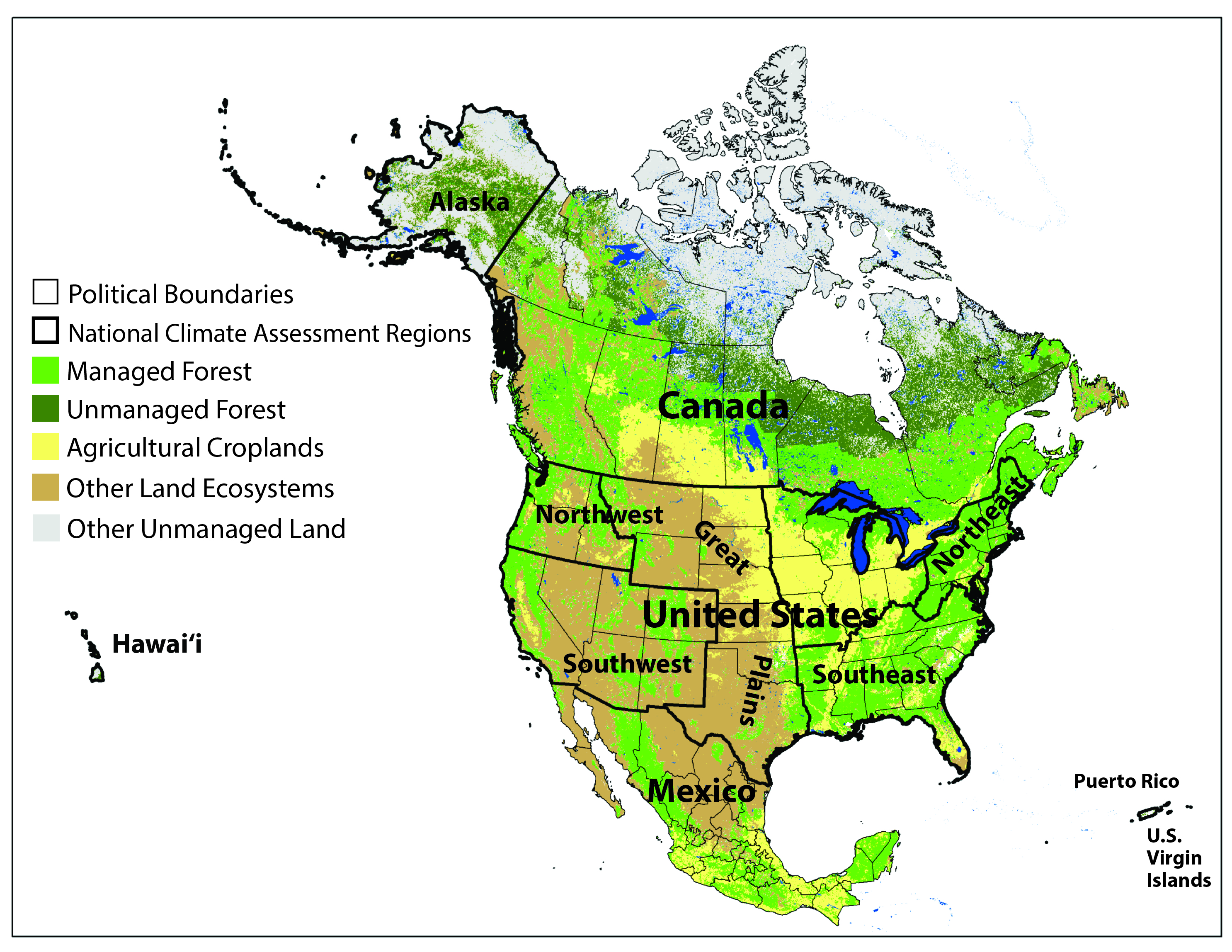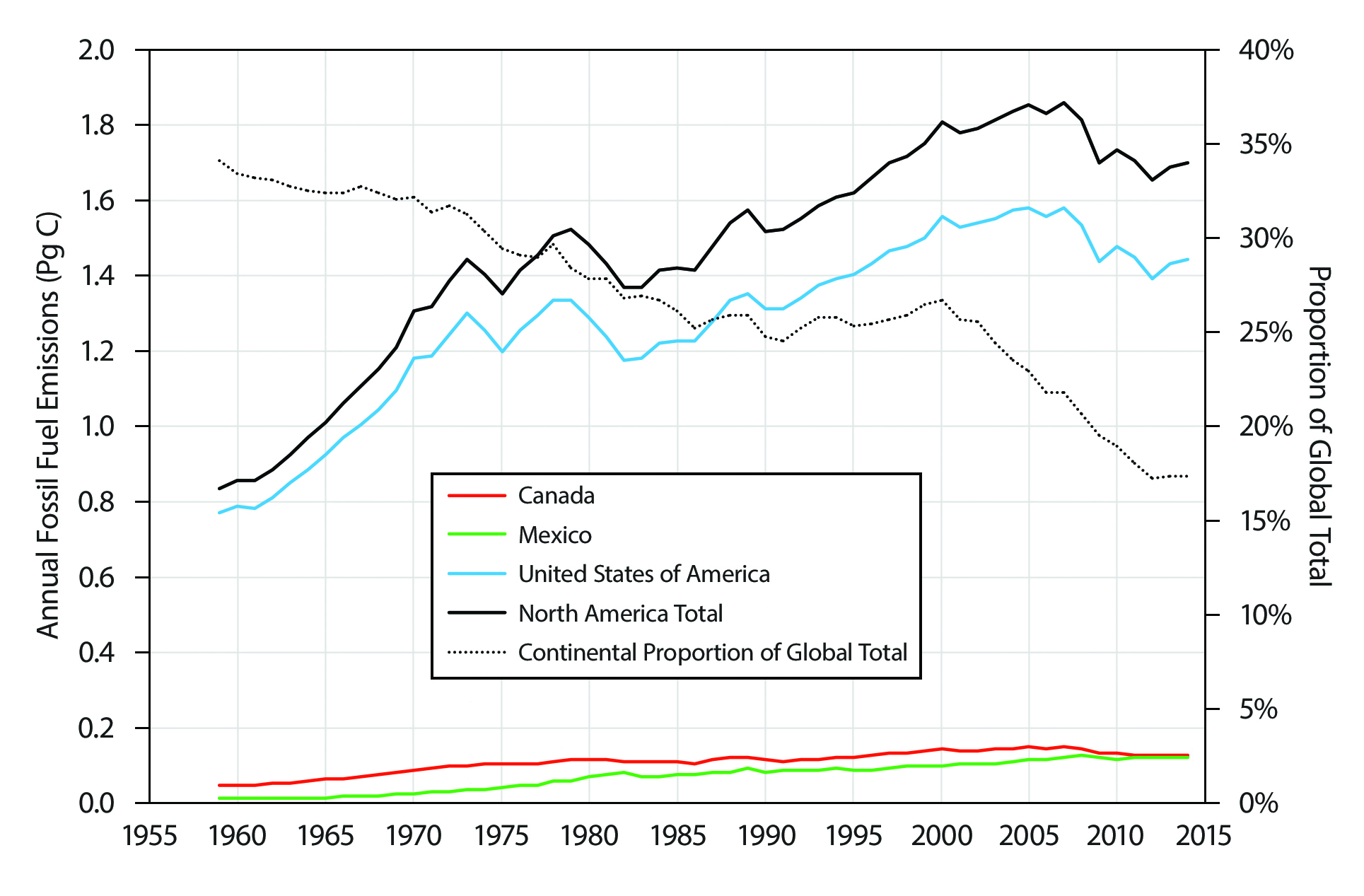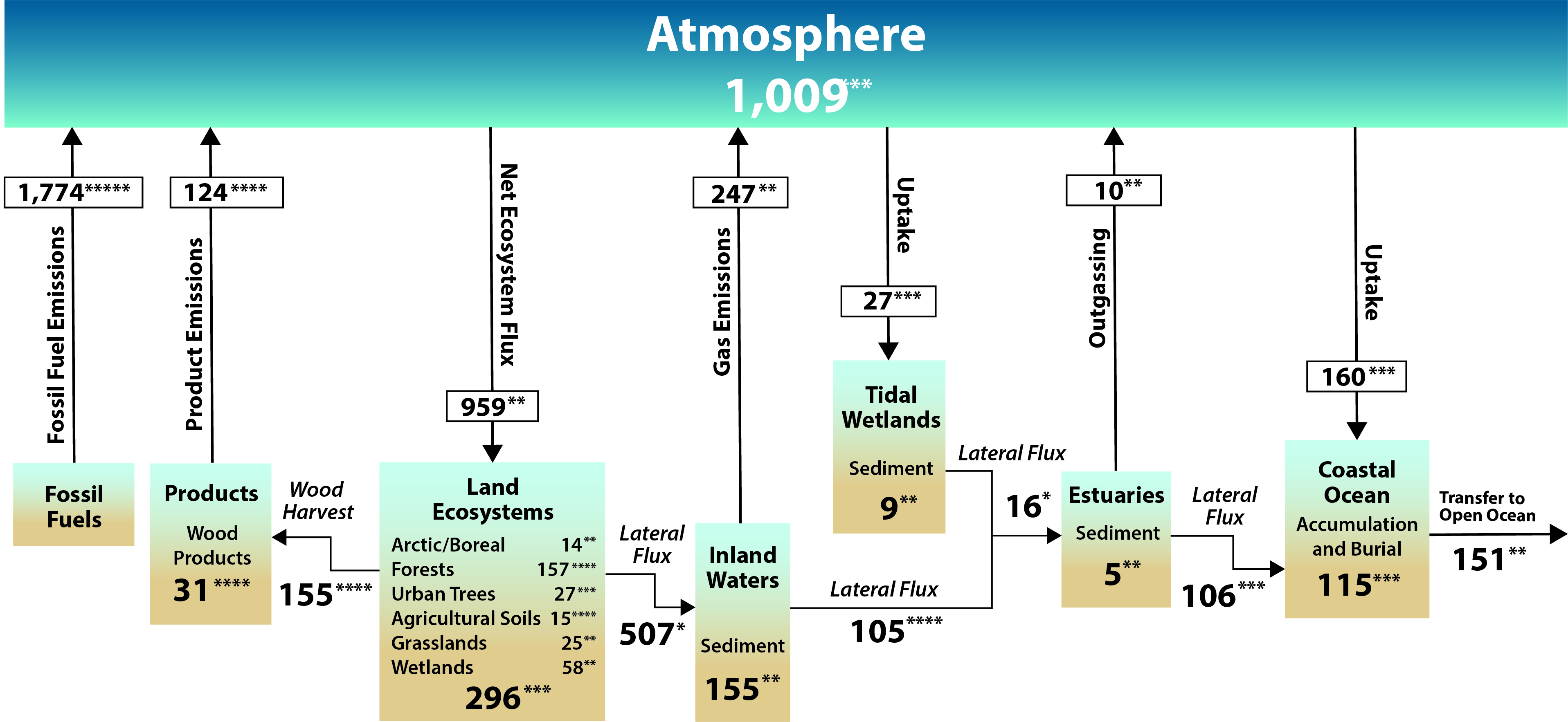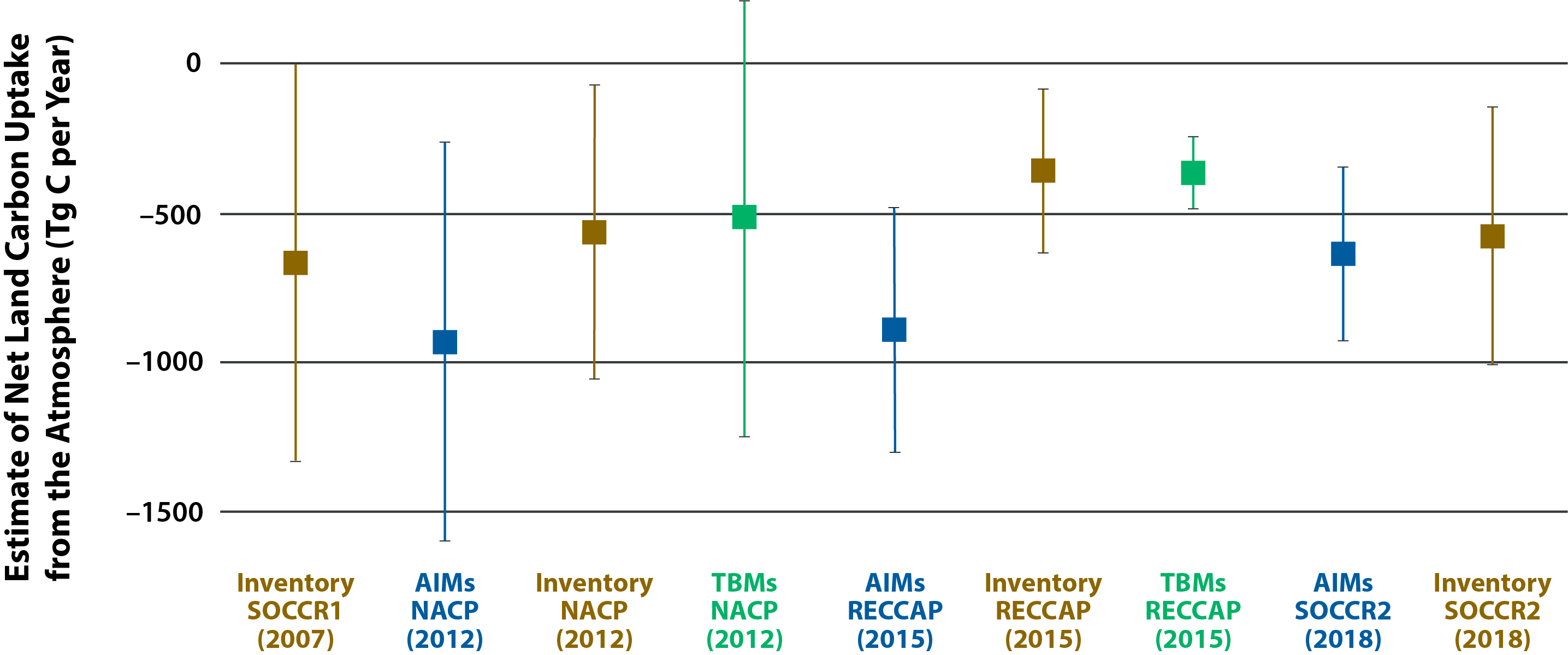2.2 Historical Context
2.2.1 Continental Net Carbon Source
A review of updated information and new studies since SOCCR1 (CCSP 2007) has established the current understanding of the North American carbon budget presented here. Previous studies have addressed the North American carbon budget for periods that preceded SOCCR1 (e.g., Goodale et al., 2002). Historically, North America is considered a net source of carbon, having contributed to the rise of global GHGs in Earth’s atmosphere over the past century (Le Quéré et al., 2016). This continental carbon source is driven entirely by anthropogenic emissions, primarily via the combustion of fossil fuels to meet energy demands from the industrial and transportation sectors of the United States, Canada, and Mexico. Since the 1970s, total fossil fuel emissions from these countries have increased approximately 1% per year according to the historical data reported in SOCCR1 (Pacala et al., 2007). In 2003, the three countries combined to emit approximately 1,900 teragrams of carbon (Tg C) per year, or about 27% of the global total according to fossil fuel inventory data at the time (Field et al., 2007). Of these three, the United States contributed 85% of that total. Although total U.S. emissions increased at a rate of about 1% per year for the 30 years leading up to 2003, the country’s per capita emissions remained relatively constant, with its carbon intensity (i.e., emissions as a function of gross domestic product) decreasing by 2% over this time period. More recent analyses suggest a 2.8% decline in total North American emissions from 2003 to 2010, with 3.4% and 7.2% decreases in the United States and Canada, respectively, countered by a 13.6% increase in Mexico (King et al., 2012). From 1990 to 2009, North American fossil fuel emissions averaged an estimated 1,700 Tg C per year (Boden et al., 2015), or 25% of the global total during this two-decade period (King et al., 2015).
Figure 2.1: Spatial Domain of the Carbon Budget Synthesis for North America

2.2.2 Continental Land and Coastal Ocean Sinks
North American land and its adjacent ocean almost certainly represent a net sink for atmospheric CO2 excluding anthropogenic emissions (King et al., 2015; Peters et al., 2007). In the ca. 2003 time frame, which includes SOCCR1, North America’s terrestrial carbon sink was estimated to be about 505 Tg C per year (±50%), representing about 15% to 40% of continental fossil fuel emissions at that time (Pacala et al., 2007). More recent analyses suggest that the terrestrial carbon sink continues to offset a substantial proportion of the carbon from fossil fuel emissions, though estimates of this proportion range from as low as 16% to as high as 52% over the last two decades (King et al., 2015). The potential North American CO2 sinks vary from 327 to 931 Tg C per year, compensating for about 35% of the continent’s fossil fuel CO2 emissions (King et al., 2012). Natural and managed ecosystems in the United States and Canada consistently have been considered a sink (ranging from 200 to 700 Tg C per year and 44 to 238 Tg C per year, respectively; King et al., 2012). Inventory-based estimates of Mexico’s carbon budget ca. 1990s suggest that the land was a source of approximately 24 to 48 Tg C per year due to emissions resulting from deforestation (Pacala et al., 2007; deJong et al., 2010). However, modeling studies—including both atmospheric inversions and terrestrial process-based approaches—have estimated Mexican ecosystems to be net sinks of about 9 to 31 Tg C per year attributed to the carbon uptake by vegetation exceeding other losses (King et al., 2012; Murray-Tortarolo et al., 2016). Overall, the North American land sector has the potential to take up an estimated 634 Tg C per year from the atmosphere, with an associated uncertainty of ±26% (King et al., 2012).
These estimates, based on combining carbon budget accounting across various sectors, attribute the sink primarily to forest growth, storage in wood products, and carbon sequestration in agricultural soils. For a more comprehensive estimate of the “apparent” sink (i.e., the total net absorption from the atmosphere), SOCCR1 expanded the inventory estimates to include the export of carbon outside the continental borders (Pacala et al., 2007). Accounting for these lateral transfers suggested a net export of carbon off the continent in the form of wood and agricultural products, as well as through river-to-ocean transport. Because these horizontal transfers are not vertical fluxes back to the atmosphere, adding them increased the estimated total North American atmospheric sink to 666 Tg C of the continent’s annual emissions.
2.2.3 Carbon Estimates: Methods, Associated Uncertainties, and Research Gaps
Confidence in inventory-based estimates of the North American carbon budget varies by sector according to the coverage of observations and measurements associated with that sector. Relative to the estimates of other components of the continental carbon cycle, the magnitudes of annual fossil fuel emissions from energy and transportation inventories in Canada, the United States, and Mexico, as reported in SOCCR1, were well known and considered with 95% confidence to be within ±10% of the estimates (CCSP 2007). The estimates for the natural carbon sink components ca. 2003 were more uncertain, considered with 95% confidence to be within ±50% of the reported estimates (Pacala et al., 2007). Studies attempting to quantify the continental-scale carbon sink have been based on 1) synthesis approaches that combine national inventory data for managed forests and agricultural lands in the United States and Canada; 2) estimates of land cover and land-use change in Mexico; and 3) bottom-up, empirical estimates of the contribution of noninventoried components.
Carbon inventories of the national forest and agricultural sectors employ one of a few different, primarily empirical, approaches, each with various levels of uncertainty associated with the estimates. The “stock-change” approach used for U.S. forests is based on the difference between complete inventories at two points in time (Heath et al., 2011; Smith et al., 2010), thus capturing the total change in ecosystem carbon (see Ch. 9: Forests). Alternatively, Canada’s national forest carbon inventory is based on the “gain-loss” method, which starts with a complete inventory that then is updated by modeling forward the components of change, such as growth, mortality, decomposition, and disturbance (Kurz et al., 2009; Stinson et al., 2011). Inventories of agricultural soils in the United States and Canada use empirical (West et al., 2010) and numerical (Environment Canada 2011) models to assess the impacts of management practices on soil organic carbon (SOC) stocks, with an uncertainty of approximately ±30% for the estimate (Hayes et al., 2012). In the United States and Canada, forest and agricultural inventory programs organize and report information on productivity, stock changes, and harvested products, but Mexico’s forestland historically has not been systematically inventoried. Instead, the country’s land estimates largely have been drawn from “bookkeeping” accounting studies (de Jong et al., 2010; Masera et al., 1997) of carbon stocks resulting from land-use change and national reports (INECC/SEMARNAT 2015). These estimates are considered to have higher uncertainty overall (±100%) because of a lack of systematic methodology and repeated inventories throughout time (Vargas et al., 2017), although a national forest inventory is now in place in Mexico and has provided new estimates in this report (see Ch. 9: Forests).
Some important contributions to continental-scale carbon stocks and fluxes have high uncertainties (or neglect an estimate altogether) for specific components and geographical regions because of the lack of standardized formal inventories or a comprehensive set of measurements across North America. Some of these factors, such as woody encroachment, arid lands, wetlands, and inland waters, have been considered to act as sinks. However, estimates of carbon stock changes in these components have relied on limited measurements or modeled data and thus are considered highly uncertain (essentially 100% of the estimated magnitude; Pacala et al., 2007). In particular, the mechanism whereby woody plants encroach into grasslands and other nonforested lands represents a potentially large flux of carbon, but also was the most uncertain component in the North American carbon budget from SOCCR1 (CCSP 2007). Measured and modeled CO2 fluxes of nonforested, noninventoried regions, such as the tundra biome (McGuire et al., 2012) and water-limited ecosystems (Ahlstrom et al., 2015; Poulter et al., 2014), suggest that these fluxes are important budget components, but ascertaining whether they act as net sinks or sources over the longer term is difficult because of their larger interannual variability.
Some potentially significant carbon budget components were not included in SOCCR1 or other synthesis efforts (e.g., King et al., 2015) due to a lack of inventories or other information sufficient for continental-scale estimation. Arguably, the most important “missing components” are 1) a large but vulnerable reservoir of carbon in northern permafrost soils (Schuur et al., 2015); 2) a potentially weakening sink in unmanaged boreal forests of interior Alaska and northern Canada (Hayes et al., 2011); and 3) the uncertain role of tidal wetlands, estuaries, and the coastal ocean in the continental budget (Bauer et al., 2013; McLeod et al., 2011). Many carbon budget synthesis studies generally have based their estimates on inventories of total carbon stock change (Pacala et al., 2007) or specifically on surface-atmosphere fluxes of CO2 (King et al., 2015). Also, historically missing from carbon budget studies is a comprehensive assessment of CH4 fluxes. Although CH4 is an important carbon-containing GHG, CH4 budget synthesis efforts have been limited to a few global-scale, atmospheric-based estimates (Dlugokencky et al., 2011) or to specific ecosystems such as wetlands (Bloom et al., 2017). Only recently have there been reports of continental-scale estimates of CH4 or other GHG fluxes, particularly from bottom-up estimates of budget components (Sheng et al., 2017; Tian et al., 2015).
Alternative scaling methods may account for some of these unknown components from the inventories, though they have their own information gaps and sources of uncertainty. Previous studies comparing atmospheric approaches based on inversion modeling over North America have suggested a much stronger land-based CO2 sink than bottom-up estimates at both regional (Hayes et al., 2011; Turner et al., 2011) and continental scales (Hayes et al., 2012; King et al., 2012; Pacala et al., 2001). For example, the NACP interim synthesis activity reported a continental terrestrial carbon sink of approximately 325 ± 77% Tg C per year, an estimate much lower than the mean atmospherically-based estimate of 931 ± 72% Tg C per year (Hayes et al., 2012). Biases in boundary conditions and transport in atmospheric inverse modeling (AIM) frameworks could have led to overestimates of the strength of the carbon sink over the mid- to high-latitude regions of North America (Göckede et al., 2010; Stephens et al., 2007). The bottom-up modeling approach, meanwhile, has exhibited an extremely large range of flux estimates as a consequence of variation in structural formulation and process representation across the ensemble of terrestrial biosphere models (TBMs), along with differences in the climate and land-use datasets used as model drivers (Huntzinger et al., 2012; Schwalm et al., 2010). Comparisons have suggested that a large contribution of the noninventoried “additional fluxes” would need to be added to the inventory-based sink estimates in SOCCR1 (Pacala et al., 2007) and the NACP synthesis (Hayes et al., 2012) to approach the magnitude suggested by the means of the AIM and TBM model ensembles (King et al., 2012). Reconciling the estimates across these various scaling approaches, King et al. (2012) concluded that the “best estimate” of the magnitude of the continental land CO2 sink early in this century was 635 ± 26% Tg C per year, offsetting about 35% of fossil fuel emissions over that time period.



